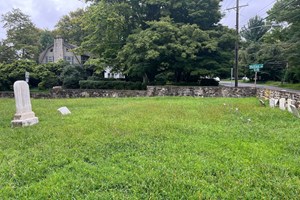William Yardley
William Yardley
1632-1693

When William Yardley was 15, an English Dissenter, George Fox, began preaching an unusual and uncompromising approach to English Puritanism. This led to the founding of the Religious Society of Friends, also called the Quakers, a year later in 1648. In 1656, at 23, Yardley began preaching on behalf of the Quakers. Two years later, he became a Quaker minister. Over the next twenty-five years, Yardley preached throughout England and was imprisoned several times along with many other Quakers, including William Penn. In one harsh imprisonment, Yardley's only resting place for three months was his cell's bare, unheated floor.
In March 1681, Penn founded the Province of Pennsylvania as a primary refuge for persecuted English Quakers. Yardley was an uncle of one of Penn's most trusted friends and counselors, Phineas Pemberton. With plans to leave England, Yardley made an agreement with Penn to buy 500 acres for ten pounds (about nineteen U.S. dollars). At age 50 in 1682, Yardley and his wife Jane (nee Heath), sons Enoch, William, and Thomas, and servant Andrew Heath sailed to America on the ship Friend's Adventure. On the ship, Yardley brought two bundles, two tubs, three chests, one pack, and two boxes of qty. 2 cwt. wrought iron, 1/2 cwt. pewter, 30 lbs., woolen cloth, 100 ells English linen, 40 lbs. new shoes, two cwt. nails; 1/2 chest window glass, 1/2 cwt. haberdashery wares.
The Yardley family made their way to Falls, Bucks County, Pennsylvania, arriving on September 28, 1682. Within the next few days, Yardley located 500 acres on the west bank of the Delaware River covering what is now Yardley, Pennsylvania. Penn gave Yardley a warranty deed on October 6, 1682, and the land officially became Yardley's about five years later, on January 23, 1687, through a land patent.
By the end of 1682, Yardley built his farmhouse on what is now called Yardley Dolington Road, about a mile from Yardley, Pennsylvania. He called his farmhouse and adjoining 500 acres of land "Prospect Farm," which still stands today. In 1683, Yardley presided over the marriage of Richard Hough, one of the first marriages among the English settlers. Richard is believed to be buried in Slate Hill near his friend William and his descendant Houghs.
Yardley was an influential man. Over the next ten years, he signed one of the frames of Pennsylvania's Great Charter, represented Bucks County in the first Pennsylvania Provincial Assembly, was a member of the Executive Council of the Province of Pennsylvania, and helped establish the Fallsington Friends Meeting. He also served as a Justice of the Peace and a Sheriff. Yardley's brother-in-law, Thomas Janney (1633–1696), wrote of him about the time of his death: "He was a man of sound mind and good understanding."
Sadly, death came to the Yardley family. His wife Jane died in 1691, and William died in 1693. In his will, William bequeathed half of "Prospect Farm" to his eldest son, Enoch, while the other half was divided between his sons William and Thomas.
The Yardleys faced further devastation when the lives of all of William's descendants were claimed. Enoch and Thomas both died on November 23, 1702. By January 1703, all five of their children had also perished. Their brother William, who remained unmarried, died in December 1702. Although the wives of Enoch and Thomas survived, they were legally barred from inheriting their husbands' property.
Due to English laws, Yardley's estate reverted to his closest male relatives in England—his brother Thomas and nephews, Thomas and Samuel.
Thomas Yardley, William's nephew, came to Bucks County in 1704 with the power of attorney of his father, Thomas, and brother, Samuel. This journey altered the course of Thomas' life. Choosing to remain in America, he thrived in this new environment. In a 1977 article, Yardley historian Catherine Belville described him as "the creative spirit of early Yardley."
Thomas married Ann Biles in 1706. Together, they raised nine children and firmly established their place in America.
There is no tombstone for William, which is not surprising. At the time, Quakers did not believe in grave markers as they were considered a sign of vanity. However, considering Yardley was a leader in the Falls Meeting and was in charge of the cemetery deed, we believe he is likely buried here and have shown the area where he would must likely lay.
Transcription of Falls Meeting Minutes 1690:
2nd day of 5th mo 1690. Agreed that the deed for the meeting house land after recording thereof be delivered to William Yardley and kept by him until further order from this meeting.
We have chosen this location to memorialize William Yardley for many reasons. First, this is the oldest area of the cemetery, so it is likely this corner is where anyone of that time period was buried. Second, Hough's descendants are nearby, and considering they were good friends, it is plausible they were buried near one another. Finally, the LMT Historical Commission took part in a ground-penetrating radar event in 2023 that clearly noted two "hits" in this spot. Without anything scientific to allow us to prove this, we've allowed our imaginations to place William Yardley & his friend Richard Hough here side by side.
